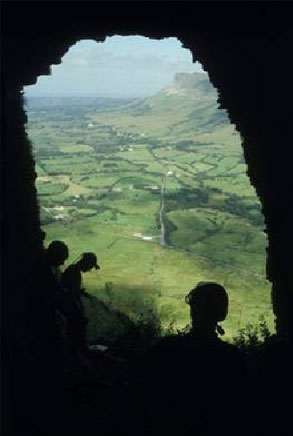TCD Researchers Trace the Ancestry of Polar Bears to Ireland
Posted on: 08 July 2011
Long ago, in Poll na mBéar, a cave carved high into a cliff face overlooking Ben Bulben and the Irish Atlantic shore, a brown bear lay down for a winter’s hibernation from which it was never to awaken. Thousands of years later, DNA from its bones has been revealed by The Smurfit Institute of Genetics, Trinity College Dublin as part of a study of the ancient genetics of bears. The study found that the female ancestor of all living polar bears was an Irish brown bear that lived prior to the peak of the last ice age, 20,000-50,000 years ago. The findings are to be published in Currently Biology.
The constant and cool temperatures within caves allow the genetic material, DNA, to survive for tens of thousands of years. Irish bears are now extinct but their remains have lain in caves around the island for forty thousand years as the earth outside has frozen in the last glaciation, warmed up, cooled again and finally warmed to the temperate climate of today. “Analysing ancient samples provides a means to go back in time and directly measure the movement of species in response to past climate change,” says study author Professor of Population Genetics, Daniel Bradley of TCD.

Poll na mBéar Cave. Photo by Dr Mike Simms.
Dr Ceiridwen Edwards,Trinity College (now Oxford University), sequenced the mitochondrial DNA of Irish bears from different time depths. Mitochondria are parts of cells with their own DNA which are passed on from mother to cub. What she found was that the older Irish bears from between 38,000 and 43,000 years ago before the ice sheets, have a genetic signature that matches bears found today in eastern parts of Europe. The last bears to survive here, from around 3,000 years ago have different sequences, which are like other western European bears of today.
However the most intriguing genetic signatures come from those bears from the several millennia (11,000-38,000 years ago) that bracket the ice age. Edwards said: “Surprisingly, when we compared the sequences from these Irish bears from cooler times to the DNA database we discovered that they were the closest yet found to those from in modern polar bears.” This implied that the maternal ancestors of this charismatic and endangered species hailed from this vicinity. However, from bone isotope analysis it is clear that unlike polar bears, the ancient Irish ice age bears did not have a marine diet.
A more complex picture emerges of the polar bear-brown bear interaction when these sequences were analysed together with a collection of modern and ancient bear sequences from around the world by co-author, Professor Beth Shapiro of the Pennsylvania State University. She said: “We found that brown bears and polar bears, which are hybridising or crossbreeding today in the wild, have been hybridising opportunistically throughout the last 100,000 years and probably longer.” This may be driven by climate changes forcing the bears to move into each other’s habitat. It is just such a hybridisation between polar bears and the extinct brown bear population sampled around the ice age in Ireland that gives the DNA patterns seen in polar bears today.
Hybridisation between related species may be more common than previously recognised and could be an important factor in their survival of sharp environmental changes – it may be prudent to afford protection to hybrids as well as purebred species as the world gears toward another climate change.
Other contributors to the study included scientists in other institutions in the USA, United Kingdom, Belgium, Spain, Denmark, Russia and Sweden.
The Irish bear DNA research was supported by The Irish Council for Science, Engineering and Technology. Other funding was provided by the European Research Council, The National Evolutionary Synthesis Center (NESCent) and the National Science Foundation.
